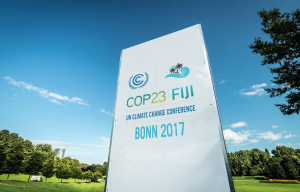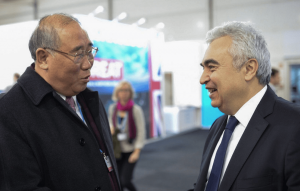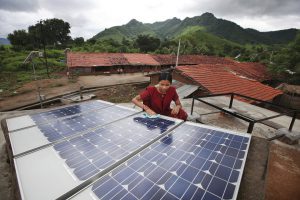In advance of President Trump’s first visit to Beijing on Wednesday, Xie Zhenhua, China’s special representative for climate change affairs, expressed hope that the US would “come back to the big family of the Paris Agreement” and called for renewed US-China cooperation in clean energy.
His comments are a reminder that US-China climate and clean energy cooperation was a high-profile success story during the Obama administration. Calling climate change a “pillar” of the bilateral relationship, President Xi and then-President Obama issued a series of joint presidential statements on climate change and expanded US-China energy and environmental engagement. In parallel, US-China leadership was seen as a catalyst for the Paris Agreement in December 2015.
But President Trump has changed course. He’s announced his intention to withdraw the US from the Paris Agreement, and narrowed and re-ordered overall priorities in the US-China relationship.
So what’s changed? And what direction might the relationship take over the next few years?
Climate less of a priority
Climate change was a prominent feature of nearly every senior US-China dialogue during the Obama administration, including presidential summits and cabinet-level meetings such as the Strategic and Economic Dialogue.
However, under President Trump, the US is unlikely to make climate change a priority issue in high-level dialogues with China. President Trump’s appointments, domestic actions, and own words indicate that he does not see climate change as a threat or a priority issue in any context, including diplomatic.
At the same time, the US has reduced the breadth of its engagement with China, opting to focus on a few high priority issues, such as trade and the Korean peninsula, through smaller-scale dialogues, further reducing the likelihood that climate change will come up at the highest levels.
China is also unlikely to raise climate change in high-level US-China dialogues at this time, with senior Chinese officials likely to focus on stabilising the overall relationship.
Areas of continuity
This downgrading of climate change in the overall US-China relationship is deeply concerning. Nevertheless, we see reasons to be optimistic.
Firstly, working-level climate and clean energy cooperation continues. The US and China share dozens of ongoing technical and policy exchanges, workshops, pilot projects, and joint research related to climate change, clean energy, and environmental protection. Most have multiple-year work plans that have continued into the Trump administration, even though climate change is not on the agenda for high-level US-China dialogues.
For example, the 8th US-China Energy Efficiency Forum was held last month in Denver. The five tracks of the US-China Clean Energy Research Center still hold regular workshops and technical dialogues. And the EcoPartnerships programme, begun under the George W Bush administration, solicited new proposals this year and announced three new partnerships last month.
Even the US Environmental Protection Agency has continued to engage with China, including by co-convening the US-China Green Ports and Vessels Initiative in Tianjin in May 2017.
Without high-level attention, some recent US-China initiatives have faded. This summer, Boston Mayor Marty Walsh cancelled a planned US-China meeting on climate change and cities because of insufficient federal government support. He later re-announced it as an international, rather than bilateral, meeting.
But these cancellations are exceptions, not rules. In some cases, US and Chinese counterparts have been working constructively together for years to advance policy and technology solutions that are beneficial to both countries and to the climate. This trust and willingness to partner continue.
Secondly, US non-federal actors remain committed to climate action, and that includes working with China. As the US federal government retreats from a global climate leadership position, American cities, states, businesses, philanthropies, and civil society actors are stepping up.
Initiatives like WeAreStillIn, the US Climate Alliance, and Climate Mayors signal to China and the entire world that many in America remain committed to ambitious climate action, as America’s Pledge seeks to quantify and communicate these commitments.
California has been particularly active in pushing ongoing US-China momentum for climate cooperation; the state has well over a dozen cooperative agreements with China on climate change, clean energy, and the environment, and California Governor Jerry Brown met with President Xi this past summer to discuss climate change cooperation and action.
Finally, China remains committed to climate action, both domestically and internationally. As US leadership on climate change has splintered, China has repeatedly affirmed its intention to fulfil its climate commitments under the Paris Agreement, and continues to push its domestic decarbonisation agenda.
China is the world’s largest renewable energy investor, now boasting the greatest installed wind and solar capacities, and electric vehicle market. To boost this market, China recently adopted the world’s first-ever national zero emission vehicle mandate, and is researching banning gasoline and diesel cars altogether. Later this month, China plans to launch what is expected to be the world’s largest national emissions trading system. Even as the US federal government abandons its climate policies, we see no evidence of China slowing down its transition to a low carbon economy.
What to expect
We expect working-level US-China climate and clean energy cooperation to continue but “energy” will receive the most attention compared to “climate”.
The Trump administration has promoted fossil fuels while eliminating references to “climate change.” Accordingly, existing US-China cooperation addressing fossil fuel-related issues (such as the CERC’s Advanced Coal Technology Consortium and the US-China Oil and Gas Industry Forum) is likely to achieve greater attention and resources over the coming years than explicitly climate-related programmes.
Nevertheless, we expect that most existing programmes will continue – with a low profile if they have to – for as long as funding remains.
We may see expanded US-China cooperation in a few energy areas, such as liquefied natural gas (LNG), wind, nuclear, and carbon capture, as well as expanded energy-related economic dialogue.
LNG trade, included in the 100-Day Action Plan of the US-China Comprehensive Economic Dialogue, is the only specific energy-related issue to have been mentioned so far by the Trump administration in the US-China context, and is a fertile area for expanded US-China engagement.
In addition to balancing overall bilateral trade, LNG exports from the US to China could contribute to China’s efforts to improve air quality and transition to a low-carbon future by quickly switching from scattered coal to gas.
There may be opportunities for expanded cooperation on wind, given US Ambassador to China Terry Branstad’s successful wind legacy from when he was governor of Iowa.
Nuclear energy and carbon capture were also flagged as opportunities by US Department of Energy Secretary Rick Perry during his visit to Beijing in June.
More broadly, the Trump administration may find opportunities for expanded dialogue with China related to the economic impacts of the clean energy transition and/or energy trade.
During the Obama administration, cooperation and dialogue on climate and clean energy were valuable not just for their content but because they produced positive news about the world’s two most influential nations working constructively together, and served as a bright spot in the overall US-China relationship.
As this new phase of the US-China bilateral relationship matures, there are some early signs that the Trump administration also recognises the diplomatic value of such positive stories. For example, “environment” – even including “addressing climate change issues” – was mentioned as a cooperative area outcome of the US-China Social and Cultural Dialogue in September 2017.
Regardless of what happens at the federal level, international action by US non-federal actors will expand and increase in profile. Local governments, businesses, technology developers, civil society, philanthropies, and other non-federal actors have major roles to play in creating and enlarging the new growth engines of low-carbon investment, trade, and research and development.
In particular, California’s international leadership will continue, culminating in September 2018 at Governor Jerry Brown’s Climate Action Summit, at which we expect robust Chinese participation.
We also expect that other states, such as Washington, which already has a strong history of clean energy engagement with China, will expand their international profiles, including by working with China.
As former senior government and government-affiliated officials, we believe in the value – indeed, the imperative – of ongoing US-China engagement on climate change.
In this new era of the US-China bilateral relationship, we see reasons to be optimistic that US-China climate and clean energy cooperation will remain strong.







